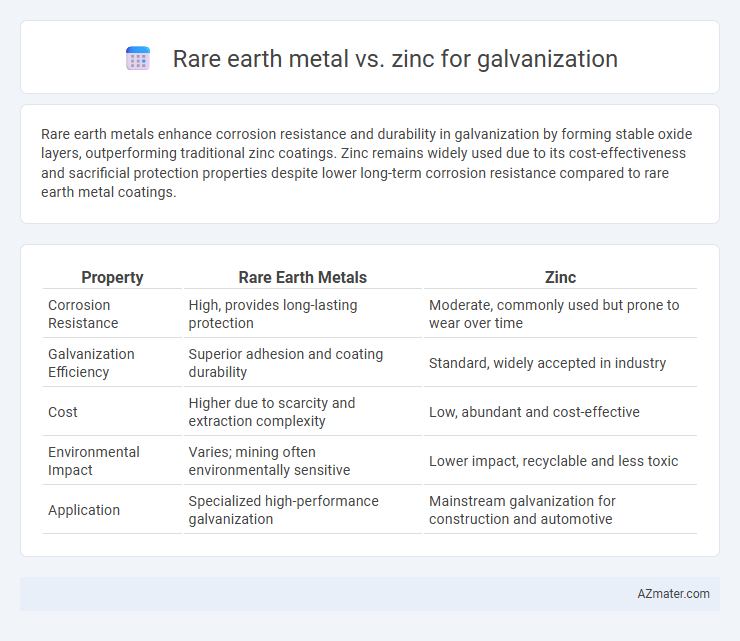Rare earth metals enhance corrosion resistance and durability in galvanization by forming stable oxide layers, outperforming traditional zinc coatings. Zinc remains widely used due to its cost-effectiveness and sacrificial protection properties despite lower long-term corrosion resistance compared to rare earth metal coatings.
Table of Comparison
| Property | Rare Earth Metals | Zinc |
|---|---|---|
| Corrosion Resistance | High, provides long-lasting protection | Moderate, commonly used but prone to wear over time |
| Galvanization Efficiency | Superior adhesion and coating durability | Standard, widely accepted in industry |
| Cost | Higher due to scarcity and extraction complexity | Low, abundant and cost-effective |
| Environmental Impact | Varies; mining often environmentally sensitive | Lower impact, recyclable and less toxic |
| Application | Specialized high-performance galvanization | Mainstream galvanization for construction and automotive |
Introduction to Galvanization
Galvanization involves coating steel or iron with a protective layer to prevent corrosion, commonly using zinc due to its excellent sacrificial properties. Rare earth metals, such as cerium or lanthanum, offer potential enhancements in corrosion resistance and coating adhesion but are less prevalent in mainstream galvanization. Zinc remains the industry standard for cost-effective and durable steel protection, while rare earth metal additives are explored for specialized applications requiring improved performance.
Overview of Rare Earth Metals
Rare earth metals, including elements like cerium and lanthanum, improve galvanization by enhancing corrosion resistance and forming a more uniform coating compared to zinc alone. These metals promote better adhesion of the protective layer and reduce the formation of white rust, extending the lifespan of galvanized steel. Their unique chemical properties enable superior performance in harsh environments, making rare earth metals a valuable alternative or supplement to traditional zinc coatings.
Properties of Zinc in Galvanization
Zinc offers excellent corrosion resistance and sacrificial protection in galvanization, forming a durable oxide layer that shields underlying steel from rust. Its ability to maintain adhesion under mechanical stress and resist atmospheric exposure makes it ideal for coating applications. Zinc's cost-effectiveness and abundance contribute to its widespread use over rare earth metals in protective galvanization processes.
Comparative Corrosion Resistance
Rare earth metals in galvanization provide superior corrosion resistance compared to zinc due to their ability to form stable, dense oxide layers that protect the underlying steel more effectively. Zinc coatings offer sacrificial protection by corroding preferentially, but rare earth metal-infused coatings enhance longevity and reduce rust formation in highly aggressive environments. Studies show rare earth metal galvanization significantly extends service life and improves resistance to pitting and general corrosion over traditional zinc coatings.
Environmental Impact: Rare Earth Metals vs Zinc
Zinc is widely used in galvanization due to its abundant availability and relatively low environmental toxicity, whereas rare earth metals, though effective in corrosion resistance, involve environmentally harmful extraction processes that generate significant waste and pollution. The mining and refining of rare earth metals often lead to habitat destruction and release of toxic byproducts, making zinc a more sustainable choice for large-scale galvanization projects. Lifecycle assessments highlight zinc's lower carbon footprint and reduced ecological impact compared to rare earth alternatives in protective coatings.
Cost and Availability Analysis
Rare earth metals are significantly more expensive and less abundant than zinc, making zinc the preferred choice for galvanization due to its cost-effectiveness and widespread availability. Zinc's global production far exceeds that of rare earth metals, ensuring consistent supply and stable pricing for industrial coating applications. The higher costs and supply constraints of rare earth metals limit their practical use in large-scale galvanization despite their corrosion-resistant properties.
Performance in Harsh Environments
Rare earth metals enhance galvanization coatings by improving corrosion resistance and durability in harsh environments, outperforming traditional zinc coatings. Zinc provides effective sacrificial protection but may degrade faster under extreme conditions such as high humidity, salt spray, or acidic atmospheres. Incorporating rare earth elements like cerium or lanthanum increases coating adhesion and oxidation resistance, extending service life in industrial and marine applications.
Industrial Applications and Use Cases
Rare earth metals enhance corrosion resistance in galvanization by improving coating adhesion and durability, making them ideal for advanced industrial applications like aerospace and automotive manufacturing. Zinc remains the primary choice for large-scale galvanization due to its cost-effectiveness and excellent protection against rust in construction, infrastructure, and electrical utilities. Combining rare earth metals with zinc coatings in specific use cases increases longevity and performance under extreme environmental conditions.
Future Trends in Galvanization Materials
Rare earth metals are emerging as promising additives in galvanization coatings due to their ability to enhance corrosion resistance and extend the lifespan of zinc-based layers. Zinc remains the primary metal for galvanization due to its cost-effectiveness and excellent sacrificial protection, but research is focused on alloying zinc with rare earth elements like cerium and lanthanum to improve coating durability and performance. Future trends point to the development of hybrid coatings combining zinc with rare earth metals to achieve superior anti-corrosive properties while addressing environmental and sustainability concerns.
Conclusion: Which is Superior for Galvanization?
Rare earth metals offer enhanced corrosion resistance and improved adhesion in galvanization compared to zinc, resulting in longer-lasting protective coatings. Zinc remains the standard due to its cost-effectiveness, availability, and proven performance in diverse environments. For applications demanding superior durability and advanced protection, rare earth metals are superior, while zinc suits general galvanization needs where budget constraints apply.

Infographic: Rare earth metal vs Zinc for Galvanization
 azmater.com
azmater.com